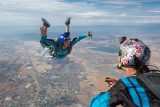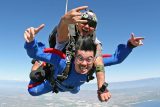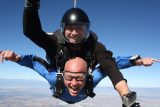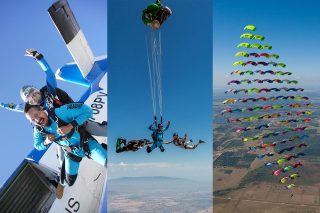Tandem Skydiving Explained
First Time Skydiving
Posted by: Skydive Perris
2 years ago
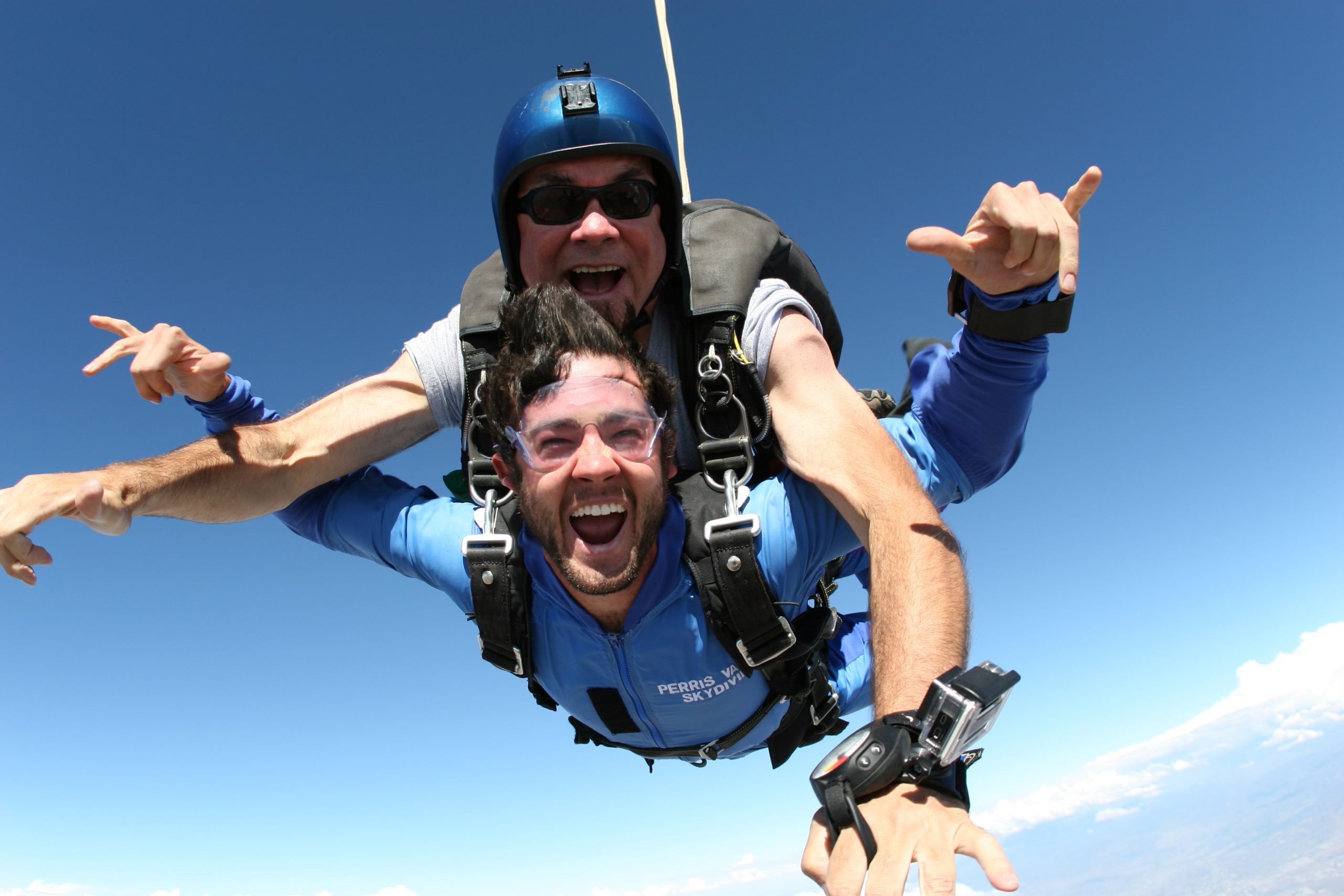
What is tandem skydiving and why is it such a predictable bucket list item for so many people? A tandem jump is essentially when two people, an instructor and a student, are attached to one another with gear specifically designed for the skydive jump … and then they leap from a perfectly good airplane together! It’s the most common way to skydive for the first time, and we’re here to tell you why skydiving tandem is so awesome!
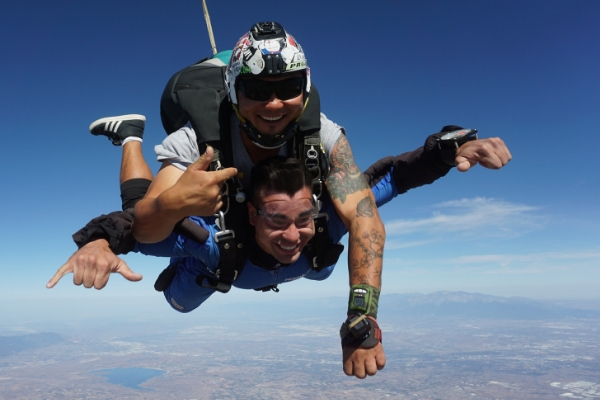
A Brief History: What is Tandem Skydiving
Tandem skydiving actually came into existence after solo civilian skydiving was already popular. Ted Strong invented the first tandem skydive system in 1984, forever revolutionizing the sport.
Vertically speaking, Strong’s system is a piggyback set up, with the tandem student in front and the tandem instructor in back. Skydiving freefall takes place in a belly-to-earth orientation, so let’s look at the tandem system from a horizontal point of view too. In this scenario, the student is lying face down and the instructor is lying face down on top of them. Of course, in freefall you don’t feel the weight of the instructor on your back – only the freedom of flight!
One other important thing to make clear … you can’t jump tandem with just anyone. As sick as it would be to jump with your skydiving buddy, that won’t be happening unless they have their tandem instructor rating. That said, if your instructor agrees and your buddy has enough experience, they could jump WITH you and come meet you in freefall!
Who Can You Go on a Tandem Skydive With?
Only D-License skydivers who are certified tandem instructors can perform tandem skydives. Let’s break that down.
In the sport of skydiving there are four license levels: A, B, C and D. Each of these is earned by achieving a certain number of jumps, logging a prescribed amount of freefall time, completing specific curriculum (including strenuous activities like intentional water landings!), and acing written exams. To be considered as a qualified candidate for the tandem instructor rating, a skydiver must first have their D license, which requires a minimum of 500 skydives and three hours of freefall time. Tandem instructor candidates then must pass a tandem skydiving course and complete probationary tandem jumps.
All of this to say: your instructor is mega qualified, experienced and credentialed. They have been vetted as a trusted and responsible skydiver who will keep you safe while making sure you have the most radical time!
Fun fact: Approximately half a million people jump for the first time by skydiving tandem every single year. Here at Skydive Perris we average 100,000 skydives annually!
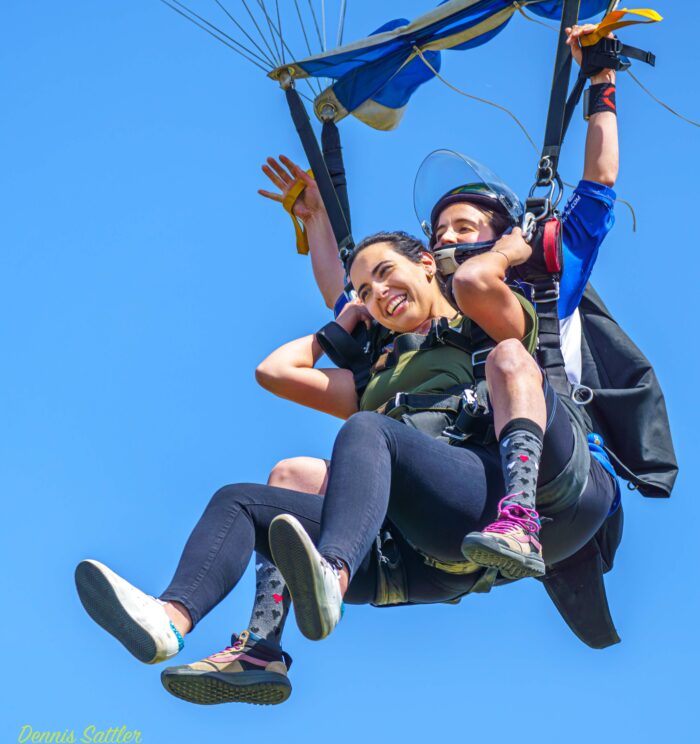
The Top Tandem Skydive Requirements and Frequently Asked Questions
What’s the age limit?
18 to infinity years old! (Bring your ID!)
Is there a weight limit?
240lbs. (Added fee if over 220lbs on our scale)
I have a disability, can I skydive?
If you think you can skydive, you probably can! We have highly skilled instructors who regularly take people with a variety of disabilities tandem instructors, including paraplegics and amputees. Call us to discuss what accommodations you might need.
What should I wear skydiving?
We’ll provide you with a super cool skydiving jumpsuit. We require closed toed shoes (no heels, boots or anything with hooks, please), and recommend dressing comfortably for the season.
Should I eat before skydiving?
Eat regularly and drink plenty of water on the day of your jump. Nausea or fainting (which rarely happens) is usually due to not eating or drinking enough.
Can I get photos of my skydive?
Uhhh, heck yeah – and you definitely should! We offer photo and video packages.
How high do we jump from?
Our tandem skydive is from 12,500 feet – that’s about 2.5 MILES UP in the sky! WOOHOOOO!
On the first Saturday of every month or for groups of three or more (call ahead, please), we offer HALO (high altitude low oxygen) jumps from 18,000 feet MSL. These special jumps require supplemental oxygen and are a true once-in-a-lifetime experience! We also have an indoor wind tunnel where you can experience the feeling of a solo freefall before your tandem jump.
Note: skydiving is the ultimate high! If you are suspected to be under the influence, you may be refused service.
Is tandem skydiving or solo skydiving safer?
Tandem skydives are inherently safer, because the person in control has a significantly higher amount of skydiving experience compared to someone doing, say, their 10th solo skydive. However, the equipment used for both types of jumps is very similar. Once you land from your tandem, though, you might want to learn to fly solo!
What happens if my tandem instructor passes out?
A short six years after tandem skydiving was invented, along came the phenomenal small but mighty AAD. An automatic activation device (AAD) is designed to automatically deploy the reserve parachute in the event that the instructor is unable to do so. Most solo (and all tandem) skydiving rigs are fitted with AAD’s and are inspected during every gear check, before every jump.
If you have other questions – reach out! And if you’re ready to book your jump, bring your bucket list and check off tandem skydiving with us!

